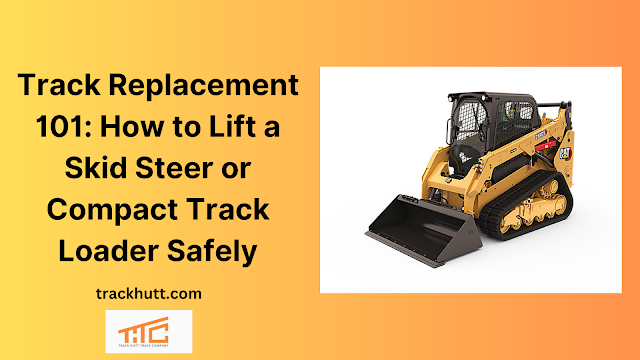Track Replacement 101: How to Lift a Skid Steer or Compact Track Loader Safely
Skid steers and compact track loaders are the workhorses of the construction, landscaping, and agricultural industries, known for their ability to tackle a variety of tasks with ease.
However, even the most reliable machinery requires regular maintenance, and installing replacement rubber tracks on a skid steer or compact track loader is one of the most common maintenance tasks.
But, let's be honest, lifting heavy machinery can be daunting, and without proper equipment and technique, it can be dangerous too. That's why we've put together this guide to help you safely lift a skid steer or compact track loader to change the tracks.
Step 1: Choose the Right Equipment
The ideal lifting equipment should have a lifting capacity that is more than the weight of the machinery being lifted. Also, the equipment should be in good working condition and properly maintained.
Some of the equipment needed to lift a skid steer or compact track loader include:
A heavy-duty jack: A jack is used to lift one side of the skid steer or compact track loader. The jack should have a lifting capacity that is more than the weight of the machinery being lifted.
Jack stands: Jack stands are used to support the skid steer or compact track loader after it has been lifted. They should be rated for the weight of the machinery being lifted.
A hoist: A hoist is used to lift the front or rear of the skid steer or compact track loader. The hoist should have a lifting capacity that is more than the weight of the machinery being lifted.
Chains or straps: Chains or straps are used to secure the skid steer or compact track loader to the hoist or jack. They should be rated for the weight of the machinery being lifted.
Step 2: Prepare the Area
Before lifting the skid steer or compact track loader, it is important to prepare the area. The area should be level and firm to ensure stability during the lifting process.
Remove any debris or obstacles that may hinder the lifting process or cause damage to the machinery being lifted. Also, ensure to invest in the best replacement rubber tracks for your skid steers for the best performance outcomes.
Step 3: Position the Equipment
Position the jack and jack stands under the skid steer or compact track loader, ensuring that they are in the correct position to lift the machinery safely.
The jack should be positioned under the chassis, and the jack stands should be positioned under the axles. Use the chains or straps to secure the machinery to the jack and jack stands.
Step 4: Lift the Skid Steer or Compact Track Loader
Start by lifting one side of the skid steer or compact track loader using the jack. Lift the machinery to the desired height and secure it using the jack stands.
Repeat the process for the other side of the machinery. If the tracks need to be changed on the front or rear, use the hoist to lift the machinery to the desired height and secure it using chains or straps.
Step 5: Change the Tracks
Once the skid steer or compact track loader is lifted and secured, remove the old tracks and replace them with new ones.
Ensure that the new replacement rubber tracks are properly aligned and tightened. Once the tracks have been changed, lower the skid steer or compact track loader back to the ground.
Step 6: Test the Machinery
Move the skid steer or compact track loader around and check for any abnormal noises or vibrations. If everything is working properly, remove the chains or straps and lower the machinery to the ground.
Wrapping Up
Maintenance is key to the longevity and performance of your skid steer or compact track loader, and changing tracks is a crucial part of it. By following the steps outlined in this guide, you can safely and efficiently change your tracks and keep your machinery running smoothly.
Don’t forget to purchase the best replacement rubber tracks from a reputed dealer. Keep digging, grading, and hauling with confidence!




Comments
Post a Comment